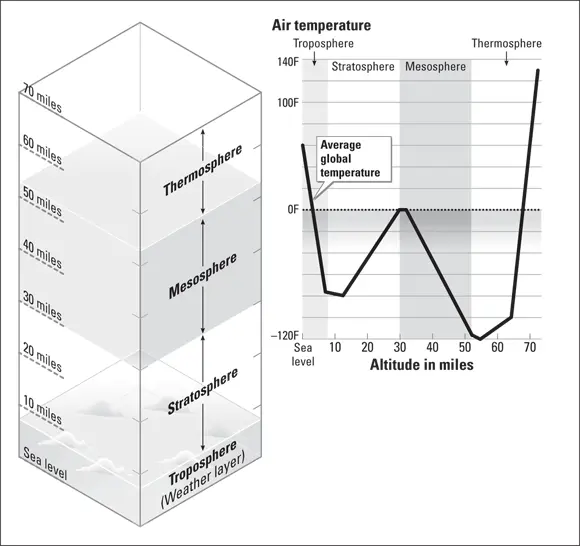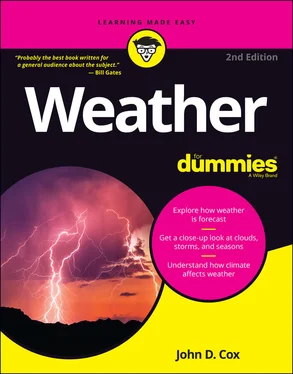The atmosphere is a thin envelope of gases surrounding Earth. Figure 3-8 lays out its contents, within about 50 miles of the surface, and quickly you can see that mostly it is nitrogen and oxygen. No, you can’t really smell the gases that make up the air. This mixture is odorless and tasteless. And you can only see it when it contains water drops or something else — when it’s dirty. Then you smell it and you can see it, even if you don’t want to. ( Chapter 14has the low-down on air pollution.)

FIGURE 3-8:The gases that make up the atmosphere.
While it makes up some 78 percent of the atmosphere, nitrogen is not in the weather-making business. It makes the natural nitrogen that is absorbed by the soil and is essential for the growth of plants. It does combine to form nitrous oxide, an important ingredient in smog, which is described in Chapter 14.
The following sections describe the gases that are most important to weather.
Oxygen, the gas that sustains all life on Earth, is constantly being recycled between the atmosphere and the biological process of plants and animals. It combines with hydrogen to form water, which in its gaseous state, water vapor, is the most important component of the atmosphere as far weather is concerned.
 The form of oxygen known as the gas ozone also is vital to life on Earth. Ozone forms a thin layer in the upper stratosphere that filters out harmful ultraviolet radiation. Chapter 14describes what happens when this crucial layer is depleted — when an ozone hole forms — and what the world’s governments are doing about it.
The form of oxygen known as the gas ozone also is vital to life on Earth. Ozone forms a thin layer in the upper stratosphere that filters out harmful ultraviolet radiation. Chapter 14describes what happens when this crucial layer is depleted — when an ozone hole forms — and what the world’s governments are doing about it.
If there is one substance in the atmosphere more involved with weather than any other, it is the gaseous form of water. At its most concentrated, water vapor makes up only 4 percent of the atmosphere, and yet, almost no important weather takes place without it.
Without water vapor to condense into droplets of water or ice crystals as air rises and cools, no clouds would form in the sky.
Without water vapor, there would be no precipitation — no rain and no snow. The cycling of water through the environment, as described in Chapter 4, would come to a screeching halt without water vapor in the atmosphere.
The condensation of water vapor leads to the release of latent heat, which is described earlier in this chapter in the sidebar “How to cause a storm.” Latent heat supplies the atmosphere with the energy that is important in the formation of storms, especially thunderstorms and hurricanes.
Water vapor also is a potent gas in the greenhouse effect, which is outlined in more detail in Chapter 14. Like the glass top of a greenhouse, it absorbs infrared heat emissions from Earth’s surface, preventing it from radiating back into space.
Like water vapor, the gas carbon dioxide has powerful greenhouse effects, trapping outgoing heat radiation, a process that is natural and beneficial — up to a point.
Carbon dioxide is constantly recycled through biological process of animals and plants. It is absorbed from the atmosphere during photosynthesis, the process by which plants take sunlight, water, and carbon dioxide and make food to grow on. In the bargain, the plants give off oxygen.
Carbon dioxide is supplied to the atmosphere through such things as the decay of plant and animal material and such human activities as timber harvesting and the emission of exhausts in the burning of fossil fuels, such as gasoline and other oil products and coal.
This gas has no direct effect on daily weather, and most of it gets washed out by rain or snow. But like all greenhouse gases, carbon dioxide has an effect on climate, weather’s long-term patterns. The concentration of carbon dioxide in the atmosphere has been steadily on the rise for more than a century. ( Chapter 14describes how increased concentrations of CO 2have led to some pretty alarming worries about global warming .)
 The variety of tiny particles of solids and liquids collectively called aerosols are not, strictly speaking, atmospheric gases. But these natural and man-made impurities in the air are very much a part of the atmosphere. They play important roles in both daily weather and in longer term climate variations.
The variety of tiny particles of solids and liquids collectively called aerosols are not, strictly speaking, atmospheric gases. But these natural and man-made impurities in the air are very much a part of the atmosphere. They play important roles in both daily weather and in longer term climate variations.
On the surfaces of these tiny floating bits of stuff, water vapor condenses to form clouds. In fact, my people at the Go Figure Academy of Sciences tell me that you cannot get a cloud to form naturally without this microscopically small flotsam and jetsam up there. Without clouds, of course, there would be no precipitation, and without precipitation — well, you get the picture. There would be no Weather For Dummies!
The atmosphere is carrying tons of aerosols, such things as soot and ash from fires, dust kicked up by winds, salt from sea spray, and large quantities of ash and droplets of gases from the eruption of volcanoes. In fact, the gigantic eruption in 1991 of Mt. Pinatubo in the Philippines threw so much material high into the atmosphere that it changed the short-term global climate. Aerosols from this single volcano filtered out sunlight, causing average surface temperatures in the Northern Hemisphere to decrease by nearly 2 degrees. This worldwide cooling effect lasted nearly two years.
On the downside, industrial processes and gasoline engine combustion releases enormous quantities of aerosols, which is responsible for the formation of smog in urban areas. Chapter 14describes these and other air-polluting effects of aerosols, including acid rain.
There is no well-defined upper boundary of the atmosphere (see Figure 3-9). It just gets thinner and thinner and thinner. It’s like the thin skin of a peach — clearly defined on one side where it covers the fruit and then fuzzy on the other.

FIGURE 3-9:Here is a map of the atmosphere’s different layers.
You could say that the atmosphere extends roughly 80 miles up, because a few molecules of the lighter gases like helium and hydrogen are still drifting around up there. But 99 percent of Earth’s sky stuff is below the top of the Stratosphere, 30 miles in the sky, and 80 percent of it is in the lower layer, the 10-mile-thick Troposphere. And as far as weather is concerned, and as far as breathing is concerned, you and I are out of business at the top of the Troposphere.
Конец ознакомительного фрагмента.
Текст предоставлен ООО «ЛитРес».
Прочитайте эту книгу целиком, купив полную легальную версию на ЛитРес.
Безопасно оплатить книгу можно банковской картой Visa, MasterCard, Maestro, со счета мобильного телефона, с платежного терминала, в салоне МТС или Связной, через PayPal, WebMoney, Яндекс.Деньги, QIWI Кошелек, бонусными картами или другим удобным Вам способом.


 The form of oxygen known as the gas ozone also is vital to life on Earth. Ozone forms a thin layer in the upper stratosphere that filters out harmful ultraviolet radiation. Chapter 14describes what happens when this crucial layer is depleted — when an ozone hole forms — and what the world’s governments are doing about it.
The form of oxygen known as the gas ozone also is vital to life on Earth. Ozone forms a thin layer in the upper stratosphere that filters out harmful ultraviolet radiation. Chapter 14describes what happens when this crucial layer is depleted — when an ozone hole forms — and what the world’s governments are doing about it. The variety of tiny particles of solids and liquids collectively called aerosols are not, strictly speaking, atmospheric gases. But these natural and man-made impurities in the air are very much a part of the atmosphere. They play important roles in both daily weather and in longer term climate variations.
The variety of tiny particles of solids and liquids collectively called aerosols are not, strictly speaking, atmospheric gases. But these natural and man-made impurities in the air are very much a part of the atmosphere. They play important roles in both daily weather and in longer term climate variations.











